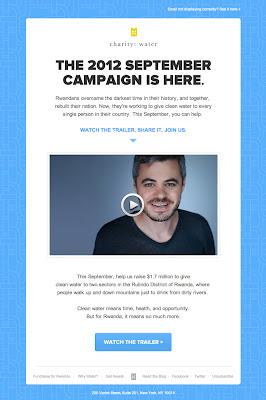Direct mail is still the king of fundraising. Despite the incessant drumbeat of speculation that direct mail is on the wane, dying, or already dead, it is still responsible for 75% of all fundraising revenue for a typical nonprofit (source: Blackbaud 2011 donorCentrics Benchmarking Report).
By the way, bad direct mail should be dead. With a stake in its heart!
Personally, I believe that the most successful fundraising strategies include a multifaceted approach. Coordinated campaigns that include complimentary direct mail, online, social media, telefundraising and personal solicitations are proving to be extremely effective.
But what would post-direct mail fundraising look like? Are alternatives to direct mail dependent campaigns really working for certain charities?
Is post-direct mail fundraising already here and does it looks like Charity:Water?
Tom Belford of the Agitator blog recently asked regarding Charity:Water's September campaign Is this any way to launch your annual appeal? He answered with a definitive "You bet it is!" And Beth Kanter recently posted about Charity:Water's brilliant use of Instagram.
The following video hints at why Charity:Water is so successful, why it connects so strongly with donors on an emotional level, and how it utilizes electronic media so well.
September Campaign 2012 Trailer: Rwanda from charity: water on Vimeo.
The video tells a great story and illustrates how Charity:Water is a key part of the story. But it has the astuteness of understanding that Charity:Water, the nonprofit, is not the story. It is all about the people of Rwanda. It is their story. The story is told clearly and simply. It promises that if you - the donor - partner with Charity:Water you can help ensure the story ends well.
Paull Young, Charity:Water's Director of Digital Engagement, recently summed up their approach this way:
- ask supporters to give up their birthdays, offering a great experience in return
- focus on sharing great content, not asking for money
- make the campaigner the hero, not the organization
- strive to have a ten year relationship with constituents
- rely 100% on social media and online platforms with no direct mail
This approach seems to be working extremely well for them. Charity:Water raised over $8.6 million in 2009 and over $16 million in 2010. All without utilizing direct mail.
Let's take a look at how they do it online. Click on this link for their September Campaign 2012.
Charity:Water leverages the web beautifully. An arresting first frame of an embedded video takes up nearly half of the page. Towards the top of the page is a progress bar showing how much has been raised so far and what the ultimate goal is. Under this first video titled "The Trailer" you see there will be four other videos that can be viewed on August 28, September 4th, 7th and 11th. These are tempting teases encouraging the visitor to return to the site. Naming the lead video The Trailer makes it seems like a movie premier and I think you will agree the clip has the impact and production values of a Hollywood blockbuster.
As you scroll down you see that you can donate now or start your own campaign. You also see that they promise to "prove" they have completed their goals with photos of each completed well site. They will even supply GPS coordinates for each project just in case you want to check them out yourself.
Lastly, as you continue to scroll down on the landing page you see project cost information, links to individuals who have started campaigns, profiles of the people they are helping, more outcome data, and information on what different levels of contributions will accomplish. Scattered throughout the page are multiple links providing ways to give, start a campaign, or receive additional information and project updates.
The entire site is beautifully designed. The data is simple and compelling. The visuals are eye-catching.
You'd be hard pressed to find anyone that does this better than Charity:Water.
Is Charity:Water unique? Could this same "no direct mail" approach work for all charities? I am not sure it could. Many nonprofits have a more complex and nuanced story to tell that may require more traditional communication media. Additionally, many prospects may be less comfortable with online giving. Perhaps more telling, many charities may not have the superb "new media" talent to pull something like this off.
What do you think? Is this the future of fundraising? Or, is this simply a superbly executed exception?



